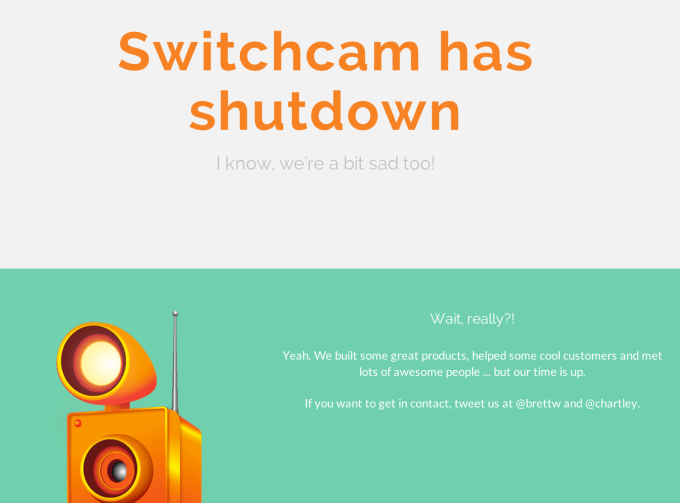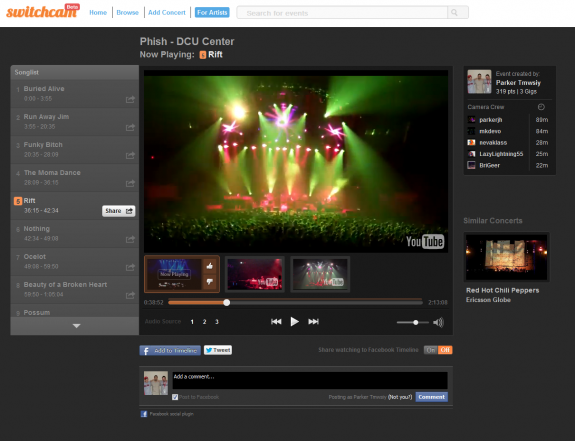Facebook’s mobile video feature is pretty awful. No multi-shot recording, stabilization, or editing. Hopefully it will get an update soon, though, as a source has tipped me off that last month Facebook hired the founders of Switchcam, a startup that specialized in video sharing. The founders Chris Hartley and Bret Welch both now list Facebook as their employer, and Switchcam has been shut down.
Hartley (right above) lists April 14th as his start date as a product engineer at Facebook, while my source says Welch (left above) traveled the world for a few weeks before beginning at Facebook this week. Welch’s Facebook about page says he became a Facebook product manager on Monday, so my source was dead on. Switchcam’s site now notes “Switchcam has shut down.” Facebook declined to comment, which is atypical for when it makes acquihires, so Hartley and Welch may have been hired through the standard application process. Since we don’t have a date of the Switchcam shut down, it’s possible the entrepreneurs may have shuttered the company and then applied to Facebook

Originally called Veokami, Switchcam was founded in 2011 to stitch together different user-generated YouTube clips of concerts or other events into multi-angle masterpieces. Switchcam’s magic was being able to sync all the videos to the same time stream by analyzing their audio.
Switchcam was part of the February 2012 500 Startups class, and the San Francisco-based company went on to raise $1.2 million from Mark Cuban, 500 Startups, Turner Media Camp and more that summer. Over the years, Switchcam worked with music festival Lollapalooza, PBS, and Anheuser Busch.

In 2013, Switchcam moved to offer an app that event organizers could give out to teams of videographers so they could purposefully record and merge videos together into something more interesting than a single static shot. Random people could also use Switchcam’s iOS app to find nearby events and volunteer to contribute their own clips, while directors could use a special dashboard to edit together the crowdsourced footage and promote their final products.
But then in February 2014, Switchcam pivoted into offering video analytics to entertainers to help them determine what were the most compelling parts of their performances. The shift to a more straightforward subscription business model may have been a sign the company was running out of cash. After Switchcam shut down, it looks like Facebook was happy to scoop up the capable video app makers.

Facecam?
The question now is what Hartley and Welch will be working on at Facebook. I don’t have inside info on this, but my guess would be Facebook’s sorely outdated video upload flow.
Facebook recently revamped its video playback, allowing videos uploaded directly to it or Instagram to auto-play in the News Feed. Almost like animated Gifs, the videos play silently as users scroll past, and the audio can be turned on with a click. Facebook gives the same preferential treatment to premium advertisers, while all other linked videos like YouTube clips stay static until clicked.

Facebook’s video recorder (pictured here) is way behind the times
So videos natively posted to Facebook are now much more eye-catching, but the upload process is still years behind Instagram, Vine, and Snapchat. The fact that Facebook’s new acquisition WhatsApp recently revealed that its users share 100 million videos a day might have clued Facebook in to the fact that people like posting videos, and highlighted how backwards its own upload flow is. As I’ve written, it’s high time for Facebook to bring its video capture feature up to speed.
Instagram has laid out a sensible blueprint for what a modern video sharing feature should look like. Tap and hold to record multiple clips, choose a cover frame that people will see in the thumbnail preview, choose to add filters and image stabilization. If Facebook simply did that, it’d be a big step up. If it wanted to go further, it could crib the ruler grid and ghost mode for stop-motion from Vine, overlaid text and drawings from Snapchat, or soundtracks from Cameo. And if it really wanted to flex, Facebook could allow you to upload multiple previously shot clips or even collaborate with friends on a video.
With the Switchcam guys aboard, Facebook has new expertise in making itself a contender in video sharing after years of neglect.
[Image Credit: AppAdvice, Glide Magazine]
